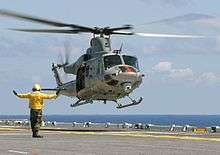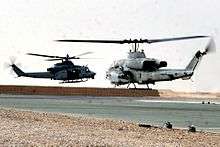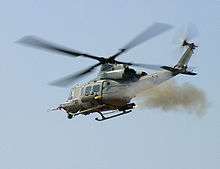Bell UH-1Y Venom
| UH-1Y Venom | |
|---|---|
| | |
| A UH-1Y flies over a live-fire range in search of simulated enemy targets | |
| Role | Utility helicopter |
| National origin | United States |
| Manufacturer | Bell Helicopter |
| First flight | 20 December 2001[1] |
| Introduction | 2008 |
| Status | In service |
| Primary user | United States Marine Corps |
| Produced | 2001–present |
| Number built | 92[2] |
| Unit cost |
US$26.2 million (flyaway cost, FY2014)[3] |
| Developed from | Bell UH-1N Twin Huey |
The Bell UH-1Y Venom[4] (also called Super Huey[5]) is a twin-engine, medium-sized utility helicopter, built by Bell Helicopter under the H-1 upgrade program of the United States Marine Corps. One of the latest members of the numerous Huey family, the UH-1Y is called also Yankee, from its variant letter.[6]
After entering service in 2008, the UH-1Y is currently in full-rate production to replace the USMC's aging fleet of UH-1N Twin Huey light utility helicopters first introduced in the early 1970s. The UH-1Y was to have been remanufactured from UH-1Ns, but in 2005, it was approved for the aircraft to be built as new.[7]
Development
In 1996, the United States Marine Corps launched the H-1 upgrade program by signing a contract with Bell Helicopter for upgrading 100 UH-1Ns into UH-1Ys and upgrading 180 AH-1Ws into AH-1Zs.[8][9] The H-1 program created completely modernized attack and utility helicopters with considerable design commonality to reduce operating costs. The UH-1Y and AH-1Z share a common tail boom, engines, rotor system, drive train, avionics architecture, software, controls and displays for over 84% identical components.[10][11]
Over the years new avionics and radios, in addition to modern door guns and safety upgrades, have greatly increased the UH-1N's empty weight. With a maximum speed of approximately 100 knots (190 km/h) and an inability to lift much more than its own crew, fuel and ammunition, the UH-1N, while useful, is limited in its utility.

The Y-model upgrades pilot avionics to a glass cockpit, adds further safety modifications and provides the UH-1 with a modern FLIR system. However, the biggest improvement is an increase in engine power. By replacing the engines and the two bladed rotor system with four composite blades the Y-model will return the Huey to the utility role for which it was designed. Originally the UH-1Y was to have been remanufactured from UH-1N airframes, but in April 2005 approval was granted to build them as new helicopters.[7][12]
The Y-model updates an airframe that has been central to the Marine Corps aviation in Iraq. The Huey has many mission requirements including command and control (C2), escort, reconnaissance, troop transport, medical evacuation and close air support. Typically detachments of 2–4 Hueys have been deployed with detachments of 4–8 Cobras. The forward mounted weaponry of the Cobra combined with the door guns of the Huey provides a 240° field of fire.
Bell delivered two UH-1Ys to the U.S. Marine Corps in February 2008.[13] As of September 2009, the UH-1Y is in full-rate production, with the Marine Corps expected to have 21 by the end of the year.[14] The Marine Corps plans to eventually buy 160 of the Y-models to replace their inventory of N-models,[15] with aircraft deliveries to be completed by 2016.[16][17]
Design
The UH-1Y variant modernizes the UH-1 design. Its most noticeable upgrade over previous variants is a four-blade, all-composite rotor system designed to withstand up to 23 mm rounds. A 21-inch (530 mm) insert just forward of the main door has been installed for more capacity. The UH-1Y features upgraded engines and transmission, a digital cockpit with flat panel multifunctional displays, and an 84% parts commonality with the AH-1Z. Compared to the UH-1N, the Y-model has increased payload, almost 50% greater range, a reduction in vibration, and higher cruise speed.[10][18][19]
Operational history

The UH-1Y and AH-1Z completed their developmental testing in early 2006.[20] During the first quarter of 2006 the UH-1Ys were transferred to the Operational Test Unit at the NAS Patuxent River, where they began operational evaluation (OPEVAL) testing.[21] In February 2008, the UH-1Y and AH-1Z began the second and final portion of OPEVAL testing.[22]
On 8 August 2008, the Marine Corps certified the UH-1Y as operationally capable and was deployed for the first time in January 2009 as part of the aviation combat element of the 13th Marine Expeditionary Unit.[23][24] The UH-1N Twin Huey was retired by the Marines in August 2014, making the UH-1Y the Marine Corps' standard utility helicopter.[25]
Operators
Specifications

Data from Bell UH-1Y guide,[10] International Directory of Civil Aircraft[33]
General characteristics
- Crew: One or two pilots, plus crew chief, other crew members as mission requires
- Capacity: 6,660 lb (3,020 kg) including up to 10 crashworthy passenger seats, 6 litters or equivalent cargo[34]
- Length: 58 ft 4 in (17.78 m)
- Rotor diameter: 48 ft 10 in (14.88 m)
- Height: 14 ft 7 in (4.5 m)
- Disc area: 1,808 ft² (168.0 m²)
- Empty weight: 11,840 lb (5,370 kg)
- Useful load: 6,660 lb (3,020 kg)
- Max. takeoff weight: 18,500 lb (8,390 kg)
- Powerplant: 2 × General Electric T700-GE-401C turboshaft, 1,828 shp for 2.5 min; 1,546 shp continuous (1,360 kW for 2.5 min; 1,150 kW continuous) each
Performance
- Never exceed speed: 198 kn (227 mph, 366 km/h)
- Maximum speed: 164 knots (189 mph, 304 km/h) for 30 minutes
- Cruise speed: 158 kt, 182 mph, 293 km/h (long range cruise (LRC): 135 kn, 155 mph, 250 km/h)
- Combat radius: 130 nmi (150 mi, 241 km) with 2,182 lb, 990 kg payload
- Endurance: 3.3 hr
- Service ceiling: 20,000+ ft (6,100+ m)
- Rate of climb: 2,520 ft/min (12.8 m/s)
Armament
- 2 external stations for 70 mm (2.75 in) Hydra 70 or APKWS II[35] rockets
- 2 pintle mounts for 7.62×51 mm M240D machine guns, .50 in (12.7 mm) GAU-16/A machine guns, or 7.62×51 mm NATO GAU-17/A Gatling guns
See also
- Related development
References
- ↑ "UH-1Y Achieves First Flight". Retrieved 2007-03-17.
- 1 2 "World Air Forces 2015 pg. 33". Flightglobal Insight. 2015. Retrieved 26 December 2014.
- ↑ "Department of Defense Fiscal Year (FY) 2014 President's Budget Submission, Aircraft Procurement, Navy, Budget Activity 01-04". Department of the Navy. April 2013. p. V1-79.
- ↑ DoD 4120-15L, Model Designation of Military Aerospace Vehicles. US DoD, 12 May 2004.
- ↑ GE Aviation (2008). "Bell UH-1Y Super Huey". Archived from the original on 6 January 2009. Retrieved 2009-06-05.
- ↑ Jane's Information Group (2008). "Bell 205 (UH-1) – Bell UH-1Y Viper Upgrade (United States), Aircraft – Rotary-wing – Military". Retrieved 2009-06-05.
- ↑ Donald, David. Modern Battlefield Warplanes. AIRTime Publishing, 2004. ISBN 1-880588-76-5.
- ↑ Bishop, Chris. Huey Cobra Gunships. Osprey Publishing, 2006. ISBN 1-84176-984-3.
- 1 2 3 Bell UH-1Y pocket guide. Bell Helicopter, March 2006. Retrieved: 20 January 2010. archived copy
- ↑ Rotorbreeze Magazine. Bell, October 2006.
- ↑ Bruno, Michael. "Wynne Approves Buy Of New UH-1Y Hueys". Aviation Week, 25 April 2005.
- ↑ "Bell H-1 upgrade program delivers two UH-1Y and one AH-1Z in February", Bell Helicopter, 3 March 2008.
- ↑ "Program Insider: H-1 Update". Rotor & Wing Magazine. 1 September 2009.
- ↑ Butler, Amy. "U.S. Marines Propose AH-1Z Production Boost" Aviation Week, 13 October 2010. Retrieved: 13 October 2010.
- ↑ Cavas, Chris (15 August 2008). "Corps certifies UH-1Y; January deployment eyed". Marine Corps Times. Retrieved 15 August 2008.
- ↑ Morris, Jefferson (18 August 2008). "Marine Corps Declares UH-1Y Operational". Aviation Week. Retrieved 18 August 2008.
- ↑ "The helicopter huey by the Bell Helicopters". Huey Helicopter Review. Retrieved 10 January 2012.
- ↑ UH-1Y page. Bell.
- ↑ Milliman, John. "AH-1Z/UH-1Y complete developmental testing". US Navy, 1 March 2006.
- ↑ "AH-1Z/UH-1Y Start OPEVAL". US Navy, 6 May 2006.
- ↑ Warwick, Graham. "US Marine Corps' Bell AH-1Z and UH-1Y enter final test phase". Flightglobal.com, 20 February 2008.
- ↑ Leland, Wendy (November–December 2008). "Airscoop". Naval Aviation News. United States Department of the Navy. p. 7. Archived from the original on 7 April 2010. Retrieved 2008-11-05.
- ↑ Morris, Jefferson. "Marine Corps Declares UH-1Y Operational". Aviation Week, 18 August 2008.
- ↑ Final Flight of UH-1N Huey for HMLA-773 - Marines.mil, 3 September 2014
- ↑ "Marine Light Attack Helicopter Squadron 167 HML/A-167 "Warriors"". tripod.com. Retrieved 12 February 2013.
- ↑ "Marine Light Attack Helicopter Squadron-169 [HMLA-169]". tripod.com. Retrieved 12 February 2013.
- ↑ "Squadron 269 transition to new helicopter". USMC.mil. Retrieved 12 February 2013.
- ↑ "MARINE LIGHT ATTACK HELICOPTER SQUADRON 367 HMLA-367 "Scarface"". tripod.com. Retrieved 12 February 2013.
- ↑ "Marine Light Attack Helicopter Squadron 469 HMLA-469 "Vengeance"". tripod.com. Retrieved 12 February 2013.
- ↑ "Final Flight of UH-1N Huey for HMLA-773". Helihub.com. Retrieved 9 January 2015.
- ↑ "Marine Light Attack Helicopter Training Squadron 303 HMLA/T-303 "Atlas"". tripod.com. Retrieved 12 February 2013.
- ↑ Frawley, Gerard: The International Directory of Civil Aircraft, 2003–2004, p. 44. Aerospace Publications Pty Ltd, 2003. ISBN 1-875671-58-7
- ↑ "UH-1Y Huey, United States of America". army-technology.com. Retrieved 10 January 2012.
- ↑ Marine helicopters deploy with laser-guided rocket - NAVAIR.Navy.mil, 17 April 2012 Archived 3 October 2012 at the Wayback Machine.
External links
| Wikimedia Commons has media related to UH-1Y Venom. |
- UH-1Y Venom page on BellHelicopter.com
- UH-1Y Venom page on US Navy RDA site
- UH-1Y Venom page on GlobalSecurity.org
- "US Navy proposes more UH-1Ys, AH-1Zs despite test phase setback", Flight International, 22 August 2008.